Are life jackets required on kayaks? It’s a question many of us have asked when venturing out onto the water for a paddling adventure. The answer may be more nuanced than simply “yes” or “no.” In this article, we’ll explore the importance of water safety, especially when it comes to kayaking, and delve into life jacket requirements and recommendations for different types of kayaks. Wearing a life jacket can mean the difference between a safe, enjoyable day on the water and a life-threatening experience – so understanding why they’re crucial is vital for any kayaker.
As we navigate our way through discussions of both legal requirements and best practices, we’ll also highlight the significance of proper life jacket selection to ensure comfort and optimal protection. Furthermore, we’ll provide practical advice for kayaking in various conditions and environments, focusing on the confidence and peace of mind that come from wearing a life jacket. Let’s paddle our way towards understanding the necessity of life jackets on kayaks and how they contribute to a worry-free aquatic adventure.
Contents
Contents
Importance Of Water Safety: The Role Of Life Jackets In Preventing Drowning Incidents
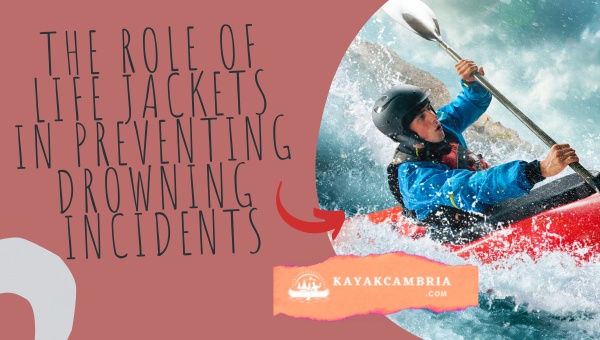
Water safety should be a top priority for anyone engaging in recreational water activities. Life jackets play a crucial role in preventing drowning incidents and ensuring a safe experience on the water. Let’s take a closer look at some key factors related to water safety and the efficacy of life jackets in reducing the risk of drowning.
Water safety statistics
According to the Centers for Disease Control and Prevention (CDC), drowning is the fifth leading cause of unintentional injury death in the United States. Alarmingly, around 80% of those drowning victims were not wearing a life jacket. This fact alone underscores the importance of wearing a life jacket during water activities like kayaking.
How life jackets save lives
Life jackets are designed to provide buoyancy, which keeps the wearer’s head above water and helps maintain a proper breathing position. They also offer thermal protection in cold water, reducing the risk of hypothermia. By doing so, life jackets significantly increase the chances of survival in the event of a mishap.
Furthermore, many life jackets feature bright colors and reflective material, making it easier for rescuers to locate individuals in distress.
Different types of life jackets for various water activities
There are several types of life jackets, each designed for specific water activities and conditions. For kayaking, you would want a life jacket (also known as a personal flotation device or PFD) that offers unrestrictive movement for paddling, as well as adequate buoyancy for your weight.
Life jackets are available in five distinct types, classified as Type I through Type V. Type III and Type V life jackets are ideal for kayaking and other paddle sports, as they provide freedom of movement, ensuring comfort and reducing fatigue during extended paddle sessions. Here’s a breakdown of the different life jacket types:
Type I: Offshore Life Jacket
Ideal for open waters and rough conditions, Type I life jackets provide the highest level of buoyancy and are designed to flip an unconscious wearer face-up. They are bulkier and less comfortable than other types but offer the most reliable flotation in extreme situations, such as commercial boating and long offshore voyages.
Type II: Near-Shore Buoyant Vest
Designed for use in calm, inland waters where rescue can be expected quickly, Type II life jackets are less bulky than Type I and provide moderate buoyancy. They can turn some unconscious wearers face-up, but it isn’t guaranteed for all cases. Type II life jackets are suitable for recreational boating close to the shore.
Type III: Flotation Aid
Type III life jackets are ideal for kayaking, canoeing, and other paddle sports. They are more comfortable, allowing for greater freedom of movement than Types I and II. While they offer less buoyancy than other types, they are still sufficient for use in calm waters where rescue can be expected relatively quickly. However, Type III life jackets may not turn an unconscious wearer face-up, so the wearer must possess some swimming ability.
Type IV: Throwable Device
Type IV life jackets are not meant to be worn but rather serve as throwable flotation devices that should be kept handy on watercraft. They come in ring buoys or boat cushions and should be readily accessible in case of an emergency. Type IV devices are designed to act as a backup to a wearable life jacket during a rescue situation.
Type V: Special-Use Device
Type V life jackets are designed for specific water activities, and their intended use is clearly marked on the label. Some examples include hybrid inflatable life vests, deck suits, and work vests. When selecting a Type V life jacket, ensure that it’s designed for the specific activity you have in mind, such as kayaking or whitewater rafting. Inflatable life jackets, which fall under this category, offer greater comfort and flexibility while maintaining buoyancy.
It is important to choose the right life jacket type based on your intended water activity and conditions, as well as ensure that it fits properly and is approved by the relevant safety authorities, such as the U.S. Coast Guard. Always verify the life jacket’s compatibility with the specific conditions in which you plan to use it.
Understanding Kayaking Regulations: What The Law Says About Life Jackets On Kayaks?

Safety should always be a top priority when participating in any water activity, and kayaking is no exception. The use of life jackets (or personal flotation devices) is regulated by both federal and state laws to help ensure the safety of kayakers. It’s important to understand the specific requirements for wearing life jackets on kayaks based on where you plan to paddle.
Federal Regulations
The United States Coast Guard (USCG) classifies kayaks as vessels, and as such, they are subject to federal regulations. According to the USCG, every kayaker is required to have a life jacket (Type I, II, III, or V) on board. Moreover, the USCG highly recommends wearing a life jacket at all times while on the water.
It’s also important to note that certain life jackets are specifically designed for kayaking and offer a higher level of comfort and mobility.
State Regulations
While federal regulations provide a general guideline for life jacket usage on kayaks, each state has its own regulations that may be more specific. Some states require all kayakers, regardless of age, to wear a life jacket, while others have age-specific mandates.
For example, in California, kayakers under 13 years old must wear a life jacket. In New York, the requirement extends to those under 12 years old. It’s crucial to review the regulations for the state in which you plan to kayak to ensure compliance and avoid potential fines and penalties.
A comprehensive list of state-by-state regulations can be found here.
Penalties for Non-Compliance
Failing to abide by life jacket regulations on kayaks can result in hefty fines and penalties. Punitive measures vary by jurisdiction but typically include monetary fines, equipment seizure, or suspension of boating privileges. To avoid facing such consequences and prioritize safety, it’s essential to always follow the life jacket laws in your area.
Understanding kayaking regulations is vital in order to stay safe and legally compliant while on the water. Wearing a life jacket on a kayak not only minimizes the risk of drowning in case of accidents but also helps maintain a responsible and enjoyable kayaking adventure.
Different Types Of Kayaks: Analyzing Life Jacket Requirements And Recommendations
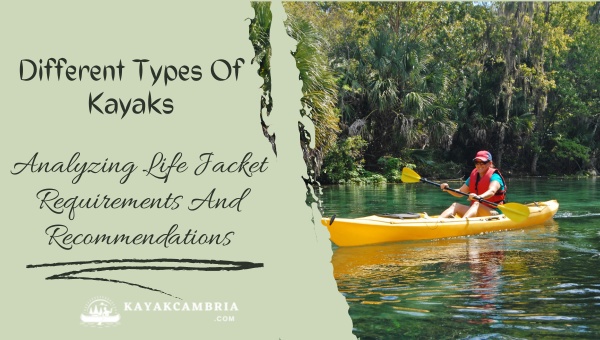
When it comes to kayaking, there is a wide variety of kayak types designed for different settings and skill levels. Understanding the specificities of these kayaks can help you make informed decisions about the right life jacket to wear, ensuring your safety and comfort during your paddling adventure. Let’s explore the different types of kayaks and their corresponding life jacket recommendations.
Recreational Kayaks
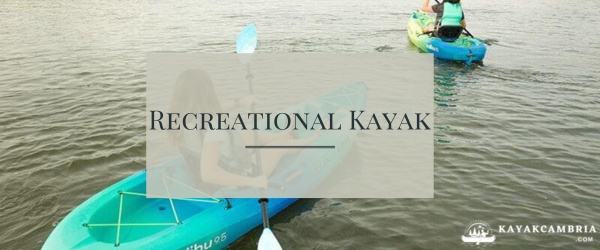
Recreational kayaks are designed for casual paddlers on calm water bodies like lakes, slow rivers, and sheltered coastal waters. They are usually stable, easy to maneuver, and relatively safe for inexperienced users. While it’s common to underestimate the need for a life jacket on leisurely paddles, it’s always better to err on the side of caution.
Life Jacket Recommendation: For recreational kayaking, a Type III personal flotation device (PFD) is an ideal choice, offering a balance of buoyancy, comfort, and freedom of movement. Look for a life jacket with large arm openings and a shorter waist for optimal ease of paddling.
Whitewater Kayaks

Whitewater kayaking involves navigating through rapids, waves, and obstacles on fast-flowing rivers. This adrenaline-packed water sport demands more advanced skills, and the risk of capsizing is higher. In situations like these, a well-fitted life jacket is crucial.
Life Jacket Recommendation: Choose a Type V PFD specifically designed for whitewater activities, which provides ample buoyancy and extra padding for added protection. High-visibility colors, a secure fit, and quick-release belts are crucial features to consider.
Fishing Kayaks

Fishing kayaks are designed for anglers, offering the convenience of fishing within hard-to-reach areas. These kayaks often have additional features like rod holders and gear compartments. Just as with any kayaking experience, wearing a life jacket is essential.
Life Jacket Recommendation: Opt for a Type III PFD that caters to anglers, with pockets to store fishing gear and attachment points for tools. Ensure your life jacket fits snugly over your fishing attire and allows for easy casting and reeling motions.
Sea and Touring Kayaks
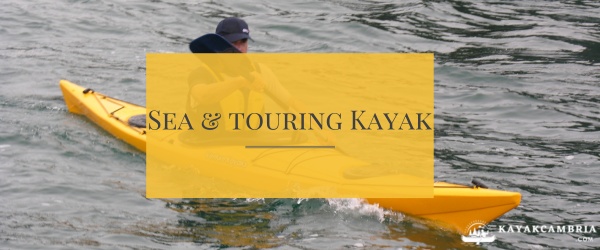
Sea and touring kayaks are built for long-distance paddles and excursions on open water, where conditions can change quickly. With their slim design and increased length, these kayaks provide enhanced speed and tracking abilities. When you’re far from the shore, staying safe in the water is paramount.
Life Jacket Recommendation: A Type III PFD with added features like a whistle, knife, and reflective tape is recommended for sea and touring kayaks. Ensure your life jacket is comfortable to wear for extended periods, and that it is compatible with your spray skirt, if applicable.
Wearing A Life Jacket An A Kayak: Focusing On Comfort, Fit, And Additional Benefits
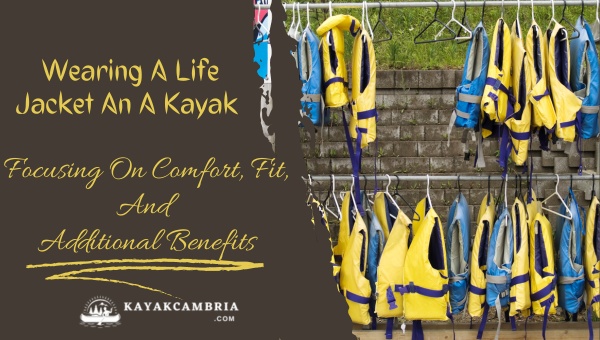
When it comes to kayaking, wearing a life jacket is crucial for ensuring a safe and enjoyable experience on the water. Selecting the right life jacket involves considering factors such as comfort, fit, and additional features specifically designed for kayakers. In this section, I’ll delve into the aspects of wearing a life jacket on a kayak that can enhance your overall paddling experience.
Comfort
One of the most important factors to consider when choosing a life jacket for kayaking is comfort. If your life jacket is uncomfortable, you may be less likely to wear it, defeating its purpose. Kayak-specific life jackets, often referred to as paddling life jackets, are designed with wider arm openings and thin foam panels to allow for a greater range of motion while paddling. These features help prevent chafing and discomfort during long hours on the water.
Fit
A life jacket that doesn’t fit properly can have serious consequences, affecting its buoyancy and potentially making it difficult to stay afloat. To ensure an optimal fit, measure your chest circumference and follow the manufacturer’s sizing guidelines when selecting a life jacket. Once you’ve chosen the right size, try it on and adjust the straps for a snug fit. The jacket should be tight enough that it won’t ride up over your face in the water but not so tight that it restricts your breathing.
Additional Benefits and Features
Life jackets designed for kayaking often come with additional features intended to make your paddling experience more pleasant and convenient. Reflective accents can help improve your visibility to other vessels, and pockets can provide storage space for essential items such as sunscreen, snacks, or a whistle. Furthermore, some life jackets come equipped with attachment points for safety accessories like a knife or a strobe light, further enhancing your safety and preparedness on the water.
When selecting a life jacket for kayaking, it’s important to prioritize comfort, fit, and features that will cater to your specific needs on the water. By doing so, you’ll ensure that your life jacket not only keeps you safe but also contributes positively to your overall kayaking experience.
Safety Tips For Kayaking With Life Jackets: Practical Advice For Worry-free Trips On The Water
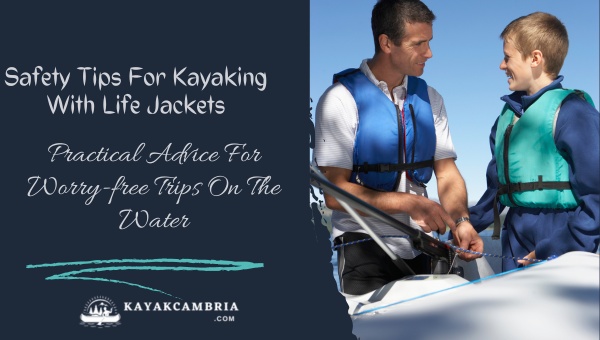
1. Choose the Right Life Jacket
Selecting the appropriate life jacket for your kayaking adventure is crucial. Different life jackets or Personal Flotation Devices (PFDs) are designed for various water activities. Ensure that your chosen life jacket is Coast Guard-approved and specifically designed for kayaking.
2. Ensure Proper Fit
A well-fitted life jacket ensures optimal safety while kayaking. Adjust the straps for a snug fit, allowing sufficient movement for paddling. Proper fit also helps prevent chafing and discomfort during extended outings.
Pro Tip: Try to lift the life jacket by its shoulder area after adjusting it. If it lifts easily and doesn’t just slide off, then you’ve got an excellent fit.
3. Conduct Research Before Heading Out
Familiarize yourself with the waterway, potential hazards, and any regulations specific to the area where you’ll be kayaking. This information aids in preparing and deciding upon the most appropriate life jacket for your outing.
4. Communicate Your Float Plan
Always inform others of your float plan. This should include details such as your departure/arrival times, route, and emergency contacts. This way, someone knows your whereabouts, and there’s a higher chance of a timely rescue if an emergency arises.
5. Be Prepared for Changing Conditions
Weather and water conditions can change rapidly, so be prepared for unexpected situations. Regularly check the forecast prior to your trip, and adjust your plans as needed.
Note: A life jacket is essential even in calm conditions, as accidents can still happen unexpectedly.
6. Bring Additional Safety Gear
In addition to a life jacket, some essential safety accessories to consider include:
- A paddle float or bilge pump for emergency self-rescue
- A whistle or air horn to signal distress or seek attention
- A signal mirror or flare gun for long-distance communication
7. Embrace the Buddy System
Kayaking with a friend or a group is not only enjoyable but also safer. Companions provide a built-in support system if an emergency arises, and you can help each other in adjusting and inspecting life jackets before heading out.
8. Take a Safety Course
Enroll in a kayaking safety course to learn valuable skills such as self-rescue techniques, hazard identification, and water safety guidelines. These courses often cover appropriate life jacket usage, ensuring that you’re well-prepared for your next kayaking adventure.
By following these safety tips and always wearing a life jacket while kayaking, you can experience worry-free trips on the water. Embrace these habits and encourage others to prioritize safety too, ultimately contributing to an enjoyable and unforgettable kayaking experience.
The Impact Of Weather And Water Conditions On Life Jacket Requirements For Kayakers
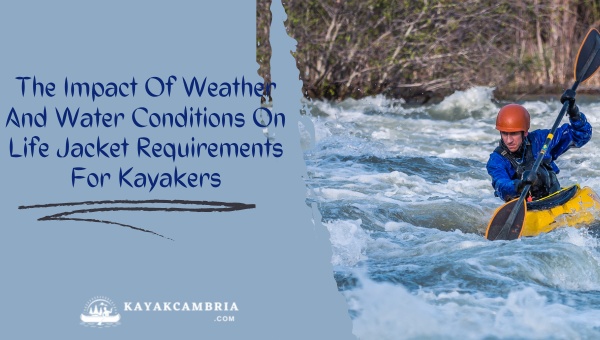
Weather and water conditions play a crucial role in the safety of kayaking adventures. As a responsible kayaker, it’s essential to understand how these factors can impact life jacket requirements during your time on the water.
Weather Forecast and Proper Preparation
Before setting out on a kayaking trip, always check the weather forecast. This will not only give you an idea of what to expect but also help you prepare accordingly. In case of predicted storms, strong winds, or sudden drops in temperature, it’s wise to postpone the trip or choose a more suitable location with calmer waters.
In colder temperatures, a well-insulated life jacket or wearing additional layers under your life jacket can provide extra warmth and protection from hypothermia. By contrast, during hot weather, you may want to choose a life jacket made from breathable materials that will help regulate body temperature, while still ensuring safety.
Adapting Life Jacket Usage for Rough Waters
Rough waters, such as those experienced in whitewater kayaking or during rough sea conditions, may require a different type of life jacket. High buoyancy life jackets designed for whitewater or rough water conditions often feature additional safety elements such as multiple buckles and straps, as well as a snug fit to keep the wearer securely in place.
Always ensure your life jacket is suitable for the water conditions you’ll be facing. The extra security could make all the difference during an unexpected capsize or challenging water situation.
Recognizing and Avoiding Dangerous Water Situations
Be vigilant when kayaking in areas with known hazards, strong currents, or swiftly changing tides. These conditions may increase the risk of accidents, making it even more important to wear a properly fitting life jacket at all times.
Additionally, be prepared for the unexpected by familiarizing yourself with capsize recovery methods, which can be invaluable if you find yourself in a dangerous situation. Practice these methods regularly so that you can recover quickly and efficiently in case of an emergency.
Remember, it’s always wise to err on the side of caution when it comes to water and weather conditions. Taking the time to understand and prepare for the challenges these elements present will ensure you have a safe, enjoyable kayaking experience – always wearing a life jacket appropriate to the conditions you might encounter.
Inspiring Confidence: How Life Jackets Help Beginners And Children Feel Safer On Kayaks?
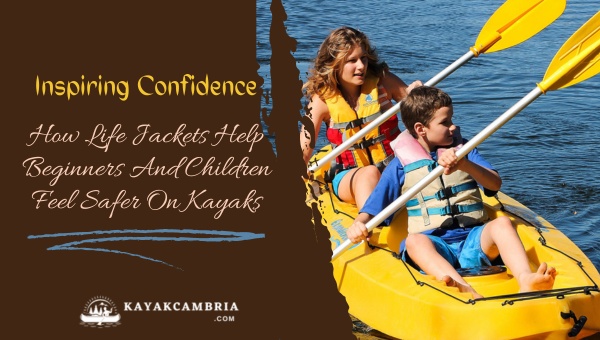
As exciting as it may be to venture out on the water, beginners, and children often feel apprehensive before their first kayaking experience. Equipping them with life jackets can significantly boost their confidence by meeting not only safety requirements but also by providing emotional reassurance.
Building Trust with Life Jackets for New Kayakers
Embarking on a kayaking adventure may be challenging, especially for those who are new to the sport or are not strong swimmers. Wearing a life jacket boosts self-assurance and allows beginners to focus on learning and enjoying their experience. By demonstrating to novices the importance of safety, they can gain trust in their own abilities and in the equipment they are using.
Child-Specific Life Jackets: Promoting Water Safety from an Early Age
Children can benefit immensely from the array of child-specific life jackets available in the market. They are designed to suit younger bodies, providing a proper fit and ensuring maximum support. When children wear life jackets designed for them, they feel secure and protected, which motivates them to learn kayaking and appreciate water-based activities. Moreover, starting children with safe habits early on establishes a strong foundation for cautious kayaking adventures in the future.
The Family Connection: Encouraging Safe Kayaking Habits within the Entire Family
A surefire way to foster a supportive environment for young and new kayakers is to model safe kayaking practices in the family. Not only does this display a commitment to safety for our loved ones, but it helps normalize the use of life jackets and other personal protective gear. When everyone in the family wears a life jacket on the water, the message is clear: safety first.
By incorporating life jackets into kayaking experiences for beginners and children, we inspire the confidence needed for them to feel comfortable and enjoy their time on the water. As they grow more skilled and daring, they will continue to prioritize safety, ensuring that their adventures remain fun and worry-free for years to come.
Group Kayaking Excursions: Implementing Life Jacket Guidelines For Organized Trips
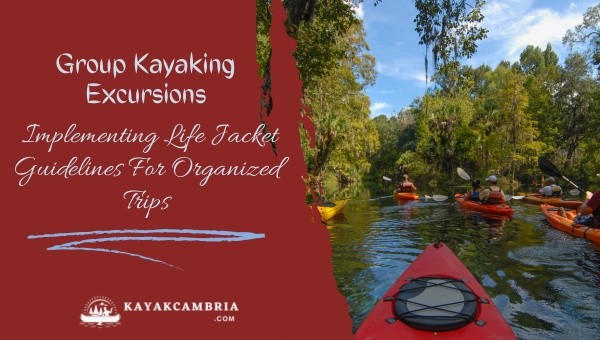
When participating in organized kayaking excursions, it is essential to implement and follow life jacket guidelines to ensure everyone’s safety while on the water. Kayaking in groups can be a fantastic way to explore new areas, socialize with fellow paddlers, and share the beauty of our waterways. However, partaking in such excursions comes with additional responsibilities – here’s what you should know to make your group kayaking trips enjoyable and safe.
Clear Life Jacket Rules
Before embarking on a group kayaking trip, the organizer should outline clear life jacket rules to encourage water safety among participants. A pre-excursion meeting may be held to discuss the importance of wearing life jackets while kayaking, proper fitting and usage, and the potential risks associated with not wearing one.
Coordinating with Tour Operators and Guides
In many group excursions, especially those organized by professional tour operators, life jacket requirements may already be in place. However, do not hesitate to coordinate with tour operators and guides to ensure that everyone in the group is equipped with a suitable life jacket and is informed about the guidelines.
Ensuring All Group Members Are Equipped with Appropriate Safety Gear
Apart from life jackets, other essential safety gear, such as helmets and spray skirts, should also be considered when preparing for a group kayaking excursion. Make certain that all group members are equipped with appropriate safety gear and that everyone understands the proper use and importance of each item.
Designating Safety Officers
Larger group excursions may benefit from designating safety officers who can oversee the use of life jackets and ensure that all participants adhere to the guidelines. Safety officers can also help in organizing essential equipment, providing instructions on proper use, and assisting in case of an emergency. This extra level of oversight helps keep everyone safer on the water.
Staying Connected and Practicing Teamwork
Group communication is vital for a safe and enjoyable kayaking excursion. Ensure that everyone is informed about communication methods during the trip (e.g., hand signals, whistle signals), and establish a buddy system for added safety. Practicing teamwork and staying connected can make a significant difference in helping prevent accidents or addressing them promptly if they occur.
Implementing life jacket guidelines during group kayaking excursions is an indispensable safety measure that should not be overlooked. Remember that when enjoying our waterways with others, safety must always be the top priority.
Sharing The Water With Other Watercraft: Guidance On Life Jacket Use In Busy Waterways
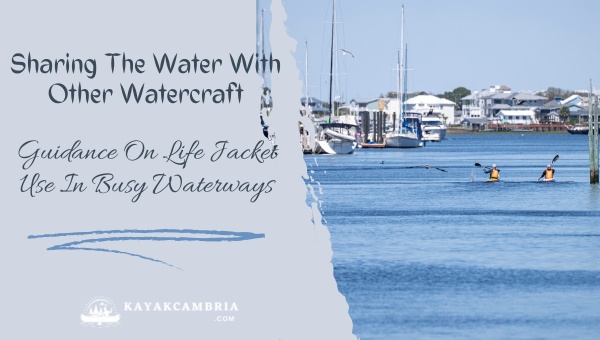
Kayaking can be a fun and exciting activity, but it’s crucial to be mindful and vigilant when sharing the water with other watercraft. Busy waterways, including motorboats, sailboats, and personal watercraft, can present challenges for kayakers. Wearing a life jacket is not only a necessary safety measure but also a way to remain visible to other boaters.
Staying visible to larger vessels
Being seen is critical when kayaking in areas with heavier boat traffic. Choosing a brightly colored life jacket becomes essential in these situations. Bold and noticeable colors, like neon orange or yellow, will make it easier for other boaters to spot you. Flying flags or using high-visibility markings on your kayak will also help you stay noticeable to others.
Right-of-way rules and how they impact kayak safety
Understanding and adhering to the right-of-way rules is crucial for your safety and that of others on the water. As a general rule, non-motorized vessels, like kayaks and canoes, have the right-of-way over motorized boats. Nonetheless, these larger vessels may not have adequate time to respond or maneuver, so it’s always wise to maintain a safe distance. Familiarize yourself with the right-of-way rules in the area where you plan to kayak and be adaptable based on the circumstances.
Extra precautions to take when kayaking near motorized watercraft
Additional measures can help you maintain a safe kayaking experience around motorized watercraft. Here are some noteworthy suggestions:
- Avoid high-traffic areas: If possible, stay away from channels, marinas, and other busy spots where boats frequently enter and exit.
- Follow the shoreline: Sticking close to the shore will reduce your chances of encountering motorboats and allow for a smoother paddling experience.
- Keep an ear out: Constantly listen for boat engines approaching you and take adequate precautions based on the boats’ direction and speed.
- Use a buddy system: Paddling with a partner or a group helps increase visibility and ensures you have support in case of any emergency.
By following these guidelines and wearing a life jacket, you will not only reinforce your safety in busy waterways but also enjoy your kayaking adventures with added confidence and peace of mind.
Going beyond The Life Jacket: Additional Safety Measures For Kayakers
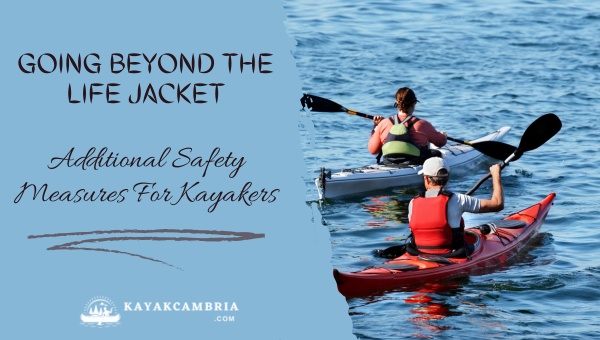
Safety on the water goes beyond just wearing a life jacket. While it is a crucial aspect in ensuring you’re protected during your kayaking adventures, there are other safety measures that you should also consider.
1. Float plans
Before embarking on any kayaking trip, it is important to have a well-thought-out float plan. A float plan involves informing someone you trust (such as a friend of a family member) about the details of your kayaking trip, including your:
- Departure and return times: This ensures someone knows when you’re expected to return and can act accordingly if you don’t return on time.
- Route: In case of emergencies, your planned route helps rescuers know where to search for you.
- Contact information: Provide them with your cell phone number or any other contact details.
It is essential to make sure you stick to your plan as closely as possible.
2. Signaling devices and communication tools
Another aspect worth considering is effective communication equipment. Some of the essential signaling devices include:
- Whistle: A whistle can be an effective means to capture someone’s attention in case of an emergency. It offers a loud, penetrating sound that travels a long distance over water.
- Signal mirror: A mirror is helpful for reflecting sunlight and signaling for help from a distance.
- Flares: Flares are useful during nighttime emergencies. They can be seen from a distance, so they make it easier for rescuers to find you.
Beyond these signaling devices, it’s also a good idea to have a waterproof communication device such as a VHF radio or a cell phone in a watertight case.
3. Adequate rest and hydration during long paddling trips
Kayaking can be tiring, especially when you’re enjoying long trips. Staying well-rested before and during your trip is essential. If you’re planning an overnight trip, make sure you have a comfortable sleeping arrangement with a tent, sleeping bag, or hammock.
Staying hydrated is equally important to ensure your physical well-being. Bring enough clean water with you. In addition, pack some electrolyte replenishment options like sports drinks or powder mixes to help your body maintain its optimal balance.
Remember that kayak safety goes beyond just wearing a life jacket. By taking additional safety measures as mentioned above, you can ensure a secure and enjoyable time on the water.
Kayak Life Jacket Laws (2024)
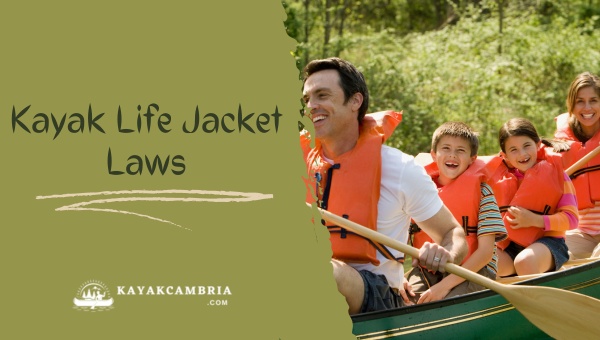
Kayaking is an enjoyable and exhilarating water activity, but staying safe on the water should always be a top priority. Life jackets are an essential part of that safety equation, and understanding the laws regarding their use when kayaking is equally important. While regulations vary depending on your location, there are general guideline that applies to all paddlers in the United States.
Federal Requirements
According to the United States Coast Guard (USCG), kayaks, canoes, and paddleboards are considered vessels, and thus subject to federal life jacket regulations. The USCG requires that all vessels, including kayaks, have at least one U.S. Coast Guard-approved Type I, II, III, or V wearable life jacket for each person on board. Though there isn’t a federal law mandating that you must wear a life jacket at all times while kayaking, it is highly recommended for safety purposes.
State Regulations
In addition to federal requirements, each state may have its own specific regulations regarding life jacket usage on kayaks. These regulations can cover factors such as minimum age requirements for wearing life jackets, and the need for additional safety equipment like whistles or lights. Some states, like California and Texas, require children under a certain age to wear life jackets at all times, while others like Alaska and Connecticut have more lenient laws.
Special Situations
In certain situations or areas, there may be more specific life jacket regulations for kayakers. For example, if you’re participating in a guided tour or a kayak rental operation, the organization may have its own requirements and policies regarding life jacket use. Furthermore, individual parks, lakes, or river systems in your state may have specific rules that apply, especially during certain seasons or under specific business conditions.
It’s crucial to understand the laws and regulations surrounding life jacket use while kayaking. Not only does wearing a life jacket increase your safety while enjoying water activities, but it also helps you stay in compliance with local laws. So before you grab your paddle and hit the water, make sure to strap on an appropriate life jacket and familiarize yourself with the rules and etiquette that apply to your area.
Kayak Life Jacket Laws By State As of 2024
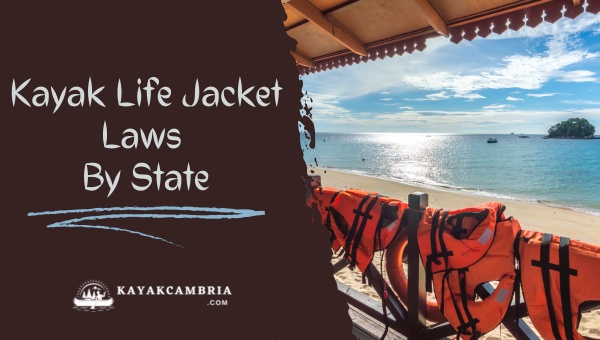
As you begin your kayaking adventures, it’s essential to understand that life jacket regulations can vary from one state to another. To ensure your safety and compliance with local laws, familiarize yourself with the specific requirements in the state where you plan to kayak. It’s essential to familiarize yourself with your state’s regulations before heading out on the water. In this section, I’ll give you a brief overview of kayak life jacket laws by state.
California
In California, paddlers aged 13 years and younger are required to wear a life jacket while on a kayak. For adults, life jackets must be readily accessible and in good condition.
Florida
Florida law requires that children aged six and under are required to wear life jackets on a kayak, canoe, or paddleboard. For those aged seven and above, including adults, the life jacket must be present and accessible on board.
Texas
In Texas, all children under the age of 13 are required to wear a life jacket while kayaking. Additionally, all adults must have life jackets on the kayak but are not obligated to wear them.
New York
New York state law requires that kayak operators and passengers under 12 years of age must wear a life jacket at all times. Furthermore, all kayaks must have wearable life jackets on board for passengers over 12 years old.
Michigan
In Michigan, all children aged six and under must wear a life jacket when kayaking, while all other individuals must have a life jacket that is readily available on the kayak.
Washington
In Washington, children aged 12 and younger must wear a life jacket. All kayakers 13 years and older must have a USCG-approved life jacket aboard their kayak.
Remember, these are only a few examples of state-specific life jacket laws. To familiarize yourself with the life jacket requirements for your kayaking destination, visit the appropriate state government website for more information.
Compliance with life jacket laws is not only a matter of legality but also a crucial step in ensuring your safety while enjoying your favorite water-based activities. It’s essential to familiarize yourself with your state’s regulations before heading out on the water.
State Kayak, Canoe, And Paddle Boarding Laws (2024)

Each state in the United States has its own regulations regarding life jackets and safety gear while kayaking, canoeing, and paddleboarding. Although laws are generally similar across the board, there are some critical distinctions to consider. Here, I will outline some general guidelines to follow, but make sure to check on your state’s specific laws by visiting your local Department of Natural Resources or a similar governing body’s website.
Age Requirements for Life Jackets
Children – In most states, it is compulsory for children under the age of 12 or 13 to wear a life jacket at all times while on kayaks, canoes, or paddleboards. Some states even have a lower age limit, such as six years old. It’s crucial to ensure your child complies with the appropriate age limit and wears a correctly sized life jacket.
Adults – Laws for adult life jacket usage on recreational watercraft like kayaks, canoes, and paddleboards may vary from state to state. While some states require all users to wear life jackets, others may simply mandate having a throwable personal flotation device (PFD) onboard.
Type of Vessel and Locations
Each type of watercraft may be governed by different life jacket regulations, depending on your state. For instance, some states may require all users on paddleboards, kayaks, and canoes to have a life jacket onboard, while others may only require children to wear one.
Additionally, specific locations, such as federally regulated waterways or parks, may enforce stricter life jacket regulations regardless of age or vessel type.
Whitewater and Open Water Regulations
When it comes to navigable rivers and white water or open water environments, more stringent life jacket requirements may be in place. This can include the need for all users to wear a life jacket at all times, regardless of age or swimming ability.
Enforcement and Penalties
Failure to follow these state laws can result in fines or penalties, such as receiving citations. However, the more significant issue at hand is the risk to you and your loved ones’ safety. It’s essential to be well-informed about the requirements and prioritize water safety at all times.
Be sure to look up the specific life jacket laws for your state, and always take the necessary precautions while kayaking, canoeing, or paddleboarding. It’s better to be safe than sorry – and enjoying your time on the water safely is the ultimate goal.
Frequently Asked Questions
1. Are life jackets mandatory while kayaking?
It varies depending on the location and the specific regulations, but in many areas, life jackets are required to be on board kayaks. Some states and regions also mandate wearing life jackets while kayaking.
2. What type of life jacket should I wear while kayaking?
Choose a life jacket that is specifically designed for paddlesports, as they provide more freedom of movement and comfort compared to standard life jackets. Look for US Coast Guard-approved Type III personal flotation devices (PFDs) suitable for kayaking.
3. Are life jackets required for children on kayaks?
Most jurisdictions have laws regarding children and life jacket usage, often requiring that children under a certain age must wear a life jacket at all times while on a kayak.
4. Do I need to wear a life jacket even if I am a strong swimmer?
Yes, it is highly recommended that everyone wear a life jacket while kayaking, regardless of their swimming ability. Accidents can happen to anyone, and wearing a life jacket significantly increases your chances of survival in case of an emergency.
5. Can I get fined for not having a life jacket on my kayak?
In areas where life jackets are required by law, you may be fined or face penalties if you do not have a life jacket on board or if you are not wearing one when required.
6. How do I ensure the proper fit for my life jacket?
Make sure the life jacket is snug but not too tight, and there should be no more than three inches of movement when lifting the shoulders. The life jacket should not ride up around the neck and should allow for full arm movement without chafing.
7. Can I use an inflatable life jacket for kayaking?
Inflatable life jackets are generally not recommended for kayaking and other paddle sports due to their potential risk of puncture and non-instantaneous inflation. It is better to opt for a foam-based PFD designed specifically for kayaking.
Conclusion
While regulations and laws surrounding life jacket requirements on kayaks may vary depending on location and water conditions, one thing remains clear: wearing a life jacket while kayaking is an essential safety measure. Life jackets play a crucial role in preventing drowning and other water-based accidents. Their use increases the chances of survival and rescue in emergency situations, ensuring that kayaking remains a fun, enjoyable, and safe outdoor activity for individuals and families alike.
When preparing for your next kayaking adventure, make sure to research the specific life jacket regulations applicable to your region and type of kayak. Remember that a properly fitted life jacket designed specifically for kayaking will provide optimal comfort and safety. Don’t forget to consider additional factors, such as weather conditions and the presence of other watercraft, when planning your outing.
Ultimately, the question “Are life jackets required on kayaks?” should be answered with a resounding “Yes!” for the sake of personal safety, as well as the well-being of others who share the water. By prioritizing life jacket use and other essential safety measures, we can all contribute to a safer kayaking experience for everyone. So, until our next paddle in the great outdoors, let’s all be responsible kayakers and wear those life jackets, regardless of our swimming abilities or the calmness of the water.

